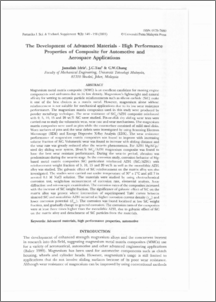Citation
Idris, Jamaliah and Tan, J. C. and Chang, C. W.
(2001)
The Development of Advanced Materials - High Performance
Properties of Composite for Automotive and
Aerospace Applications.
Pertanika Journal of Science & Technology, 9 (2).
pp. 149-158.
ISSN 0128-7680
Abstract
Magnesium metal matrix composite (MMC) is an excellent candidate for moving engine components and airframes due to its low density. Magnesium's lightweight and natural
affinity for wetting to ceramic particle reinforcements such as silicon carbide (SiC) make it one of the best choices as a matrix metal. However, magnesium alone without
reinforcement is not suitable for mechanical applications due to its low wear resistance performance. The magnesium matrix composites used in this study were produced by
powder metallurgy technique. The wear resistance of SiC/AZ91 composite reinforced with 0, 5, 10, 15 and 20 wt.% SiC were studied. Pin-<>n-disk dry sliding wear tests were
carried out to study the volumetric wear, wear rate and wear mechanisms. The magnesium matrix composites were used as pins while the counter face consisted of mild steel disks. Worn surfaces of pins and the wear debris were investigated by using Scanning Electron
Microscopy (SEM) and Energy Dispersive X-Ray Analysis (EDX). The wear resistance
performance of magnesium matrix composites was found to improve with increasing
volume fraction of SiC. Volumetric wear was found to increase with sliding distance and
the wear rate was greatly reduced after the wear-in phenomenon. For AZ91 Mg-SiCp/
steel dry sliding wear system, 2D-wt.% SiC/AZ91 magnesium composite was found to
have the best wear resistant performance. During the wear-in period, abrasion was
predominant during the wear-in stage. In the corrosion study, corrosion behavior of Mgbased
metal matrix composites SiC particulate reinforced AZ91 (SiC/AZ91) with
reinforcement weight fraction of 5, 10, 15 and 20 wt.% as well as the monolithic AZ91
alloy was studied. The galvanic effect of SiC reinforcement on the matrix alloy was also
investigated. The studies were carried out under temperature of 30° ± 1°C and pH 7 in
aerated 0.1 M NaCI solution. The materials were studied by using electrochemical
corrosion test, weight-loss measurement of corrosion rate, elemental analysis, X-ray
diffraction and microscopic examination. The corrosion rates of the composites increased
with the increase of SiC weight fraction. The significance of galvanic effect of SiC on the
matrix alloy was proven where intersection of superimposed Tafel curves between
sintered SiC and monolithic AZ91 occurred at higher corrosion current density (i...,) and
lower corrosion potential (E...,). The corrosion was found localized at low SiC weight
fraction, and gradually change to general corrosion. The corrosion rates of the composites
were at least three times higher than the monolithic AZ91, due to galvanic effect of SiC
on the matrix alloy and detachment of SiC particles from the materials.
Download File
![[img]](http://psasir.upm.edu.my/style/images/fileicons/application_pdf.png)  Preview |
|
PDF
The_Development_of_Advanced_Materials_-_High_Performance.pdf
Download (2MB)
|
|
Additional Metadata
Actions (login required)
 |
View Item |

